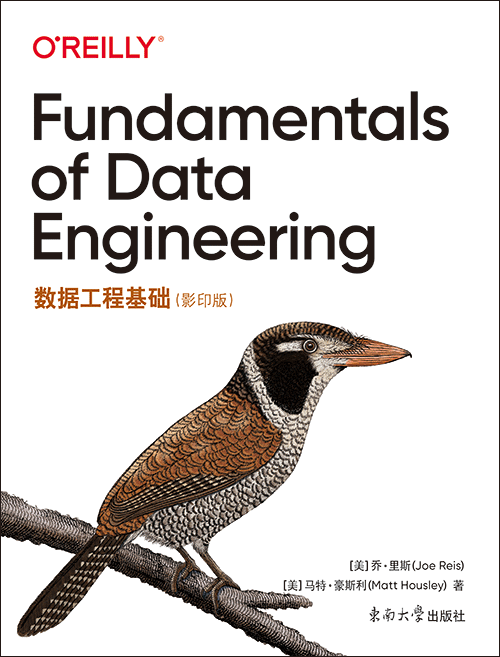数据工程基础(影印版)
出版时间:2023年03月
页数:422
“数据世界已经演变了有一段时间。首先是设计师,然后是数据库管理员,接着是首席信息官和数据架构师。本书标志着该行业演变和成熟的下一步。对那些忠于自己职业和事业的人来说,这是一本必读之书。”
——Bill Inmon
数据仓库的创建人
“本书很好地介绍了数据移动、处理和操作。我强烈将它推荐给任何想要快速掌握数据工程或分析的读者,或者想要填补理解上的空白的现有从业者。”
——Jordan Tigani
MotherDuck 创始人兼首席执行官,
BigQuery的创始工程师和共同创始人
数据工程在过去十年间发展迅速,许多软件工程师、数据科学家和分析师都在寻找相关实践的全面观点。通过这本实践用书,你将学习如何通过评估数据工程生命周期框架中可用的最佳技术来规划和构建系统,以满足你的组织和客户的需求。
作者Joe Reis和Matt Housley将为你介绍数据工程的生命周期,向你展示如何综合运用各种云技术,以满足下游数据消费者的需求。你将理解如何应用数据生成、摄取、编排、转换、存储和治理的概念,无论底层技术是什么,这些概念在任何数据环境中都至关重要。
本书将帮助你:
● 简要了解整个数据工程领域
● 使用端到端的最佳实践框架评估数据工程问题
● 在选择数据技术、架构和流程时避开市场营销炒作
● 使用数据工程生命周期来设计和构建稳健的架构
● 在数据工程生命周期中融入数据治理和安全性
——Bill Inmon
数据仓库的创建人
“本书很好地介绍了数据移动、处理和操作。我强烈将它推荐给任何想要快速掌握数据工程或分析的读者,或者想要填补理解上的空白的现有从业者。”
——Jordan Tigani
MotherDuck 创始人兼首席执行官,
BigQuery的创始工程师和共同创始人
数据工程在过去十年间发展迅速,许多软件工程师、数据科学家和分析师都在寻找相关实践的全面观点。通过这本实践用书,你将学习如何通过评估数据工程生命周期框架中可用的最佳技术来规划和构建系统,以满足你的组织和客户的需求。
作者Joe Reis和Matt Housley将为你介绍数据工程的生命周期,向你展示如何综合运用各种云技术,以满足下游数据消费者的需求。你将理解如何应用数据生成、摄取、编排、转换、存储和治理的概念,无论底层技术是什么,这些概念在任何数据环境中都至关重要。
本书将帮助你:
● 简要了解整个数据工程领域
● 使用端到端的最佳实践框架评估数据工程问题
● 在选择数据技术、架构和流程时避开市场营销炒作
● 使用数据工程生命周期来设计和构建稳健的架构
● 在数据工程生命周期中融入数据治理和安全性
- Preface
- Part I. Foundation and Building Blocks
- 1. Data Engineering Described
- What Is Data Engineering?
- Data Engineering Skills and Activities
- Data Engineers Inside an Organization
- Conclusion
- Additional Resources
- 2. The Data Engineering Lifecycle
- What Is the Data Engineering Lifecycle?
- Major Undercurrents Across the Data Engineering Lifecycle
- Conclusion
- Additional Resources
- 3. Designing Good Data Architecture
- What Is Data Architecture?
- Principles of Good Data Architecture
- Major Architecture Concepts
- Examples and Types of Data Architecture
- Who’s Involved with Designing a Data Architecture?
- Conclusion
- Additional Resources
- 4. Choosing Technologies Across the Data Engineering Lifecycle
- Team Size and Capabilities
- Speed to Market
- Interoperability
- Cost Optimization and Business Value
- Today Versus the Future: Immutable Versus Transitory Technologies
- Location
- Build Versus Buy
- Monolith Versus Modular
- Serverless Versus Servers
- Optimization, Performance, and the Benchmark Wars
- Undercurrents and Their Impacts on Choosing Technologies
- Conclusion
- Additional Resources
- Part II. The Data Engineering Lifecycle in Depth
- 5. Data Generation in Source Systems
- Sources of Data: How Is Data Created?
- Source Systems: Main Ideas
- Source System Practical Details
- Whom You’ll Work With
- Undercurrents and Their Impact on Source Systems
- Conclusion
- Additional Resources
- 6. Storage
- Raw Ingredients of Data Storage
- Data Storage Systems
- Data Engineering Storage Abstractions
- Big Ideas and Trends in Storage
- Whom You’ll Work With
- Undercurrents
- Conclusion
- Additional Resources
- 7. Ingestion
- What Is Data Ingestion?
- Key Engineering Considerations for the Ingestion Phase
- Batch Ingestion Considerations
- Message and Stream Ingestion Considerations
- Ways to Ingest Data
- Whom You’ll Work With
- Undercurrents
- Conclusion
- Additional Resources
- 8. Queries, Modeling, and Transformation
- Queries
- Data Modeling
- Transformations
- Whom You’ll Work With
- Undercurrents
- Conclusion
- Additional Resources
- 9. Serving Data for Analytics, Machine Learning, and Reverse ETL
- General Considerations for Serving Data
- Analytics
- Machine Learning
- What a Data Engineer Should Know About ML
- Ways to Serve Data for Analytics and ML
- Reverse ETL
- Whom You’ll Work With
- Undercurrents
- Conclusion
- Additional Resources
- Part III. Security, Privacy, and the Future of Data Engineering
- 10. Security and Privacy
- People
- Processes
- Technology
- Conclusion
- Additional Resources
- 11. The Future of Data Engineering
- The Data Engineering Lifecycle Isn’t Going Away
- The Decline of Complexity and the Rise of Easy-to-Use Data Tools
- The Cloud-Scale Data OS and Improved Interoperability
- “Enterprisey” Data Engineering
- Titles and Responsibilities Will Morph...
- Moving Beyond the Modern Data Stack, Toward the Live Data Stack
- Conclusion
- A. Serialization and Compression Technical Details
- B. Cloud Networking
- Index
书名:数据工程基础(影印版)
作者:Joe Reis, Matt Housley 著
国内出版社:东南大学出版社
出版时间:2023年03月
页数:422
书号:978-7-5766-0551-8
原版书书名:Fundamentals of Data Engineering
原版书出版商:O'Reilly Media
The animal on the cover of Fundamentals of Data Engineering is the white-eared puffbird (Nystalus chacuru).
So named for the conspicuous patch of white at their ears, as well as for their fluffy plumage, these small, rotund birds are found across a wide swath of central South America, where they inhabit forest edges and savanna.
White-eared puffbirds are sit-and-wait hunters, perching in open spaces for long periods and feeding opportunistically on insects, lizards, and even small mammals that happen to come near. They are most often found alone or in pairs and are relatively quiet birds, vocalizing only rarely.
The International Union for Conservation of Nature has listed the white-eared puffbird as being of least concern, due, in part, to their extensive range and stable population。
So named for the conspicuous patch of white at their ears, as well as for their fluffy plumage, these small, rotund birds are found across a wide swath of central South America, where they inhabit forest edges and savanna.
White-eared puffbirds are sit-and-wait hunters, perching in open spaces for long periods and feeding opportunistically on insects, lizards, and even small mammals that happen to come near. They are most often found alone or in pairs and are relatively quiet birds, vocalizing only rarely.
The International Union for Conservation of Nature has listed the white-eared puffbird as being of least concern, due, in part, to their extensive range and stable population。
购买选项
